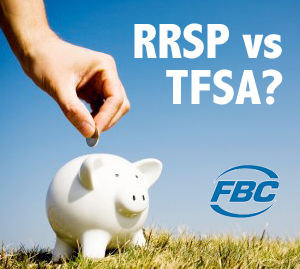Contents
Last updated: Jan. 28, 2013
 A 2012 BMO study, conducted by Leger Marketing, found that while about two-thirds of Canadians are knowledgeable about registered retirement savings plans (RRSPs) and tax-free savings accounts (TFSAs), 40% of Canadians remain unclear on the differences between the two.
A 2012 BMO study, conducted by Leger Marketing, found that while about two-thirds of Canadians are knowledgeable about registered retirement savings plans (RRSPs) and tax-free savings accounts (TFSAs), 40% of Canadians remain unclear on the differences between the two.
Do you know the differences? Do you know which works best for your situation?
Just in time for tax season, we present FBC’s primer to TFSAs and RRSPs.
So, what are the differences between a TFSA and an RRSP:
- Contributions to your RRSP are tax-deductible on your income tax return; contributions to a TFSA are not tax-deductible.
- With a TFSA, you do not need to have any earned income to accumulate the $5,000 per year contribution room; with an RRSP, you must have earned income in order to accumulate contribution room.
- Both plans provide for tax-free growth but only the TFSA allows the contributor to withdraw the growth tax free.
- Investments held in both plans include cash, stocks, ETFs, mutual funds, securities, government and corporate bonds, and term deposits.
- Withdrawals from a TFSA are tax-free. Any amount withdrawn is then added to your contribution room in the following year, so that you can later re-contribute the amount that you withdrew; withdrawals from an RRSP are taxed in the year of withdrawal (with the exception of the Home Buyer’s Plan (HBP) and Lifelong Learning Plan (LLP)). Any amount withdrawn cannot be added to your contribution room in the following year.
- Collapsing the plan: an RRSP must be fully withdrawn or be transferred to a RRIF or annuity by the end of the year you turn 71; there is no age requirement to convert the TFSA.
- In the case of death of the holder, both plans can be rolled over to the spouse tax free but only the RRSP is taxed if it goes to other beneficiaries.
Which should you choose – TFSA or RRSP? That depends.
- Attribution rules
The attribution rules (income splitting) do not apply to TFSA. A higher income spouse can gift cash to lower or non-income earning spouses without triggering any tax consequences. This also includes children over 18, parents, and grandparents. Spousal RRSP do have attribution rules albeit only for the current and two preceding year contributions.
- Seniors
TFSA withdrawals will not be included in income for tax purposes therefore they will not affect the clawbacks on OAS, GIS and GST rebates. Any other federal provincial incentive programs that use net income for qualification will not be included.
- Withholding tax on withdrawals
There are no withholding taxes on withdrawals for a TFSA while there are for RRSP and RRIF. So if you need $10,000 all you need to withdraw is the same amount in your TFSA while it would be $12,500 in your RRSP. Withholding rates for RRSP:
Up to $5,000 – 10%
$5,001 to 15,000 – 20%
Over $15,001 – 30%
- RRSP deduction
The advantage an RRSP has is the upfront tax deduction it provides on the income tax form at your highest tax bracket while a TFSA is a contribution based on after tax income. This is why we always recommend a tax planning and financial specialist be consulted to determine the best investment option given your own personal circumstances.
- It’s better to invest in a TFSA if your funds are limited.
- For taxpayers who earn less than $60,000, it is better to invest in a TFSA due to the current tax rates.
- Taxpayers earning more than $60,000 are better off contributing to their RRSPs.
- One thing is certain … we need to save for retirement!
